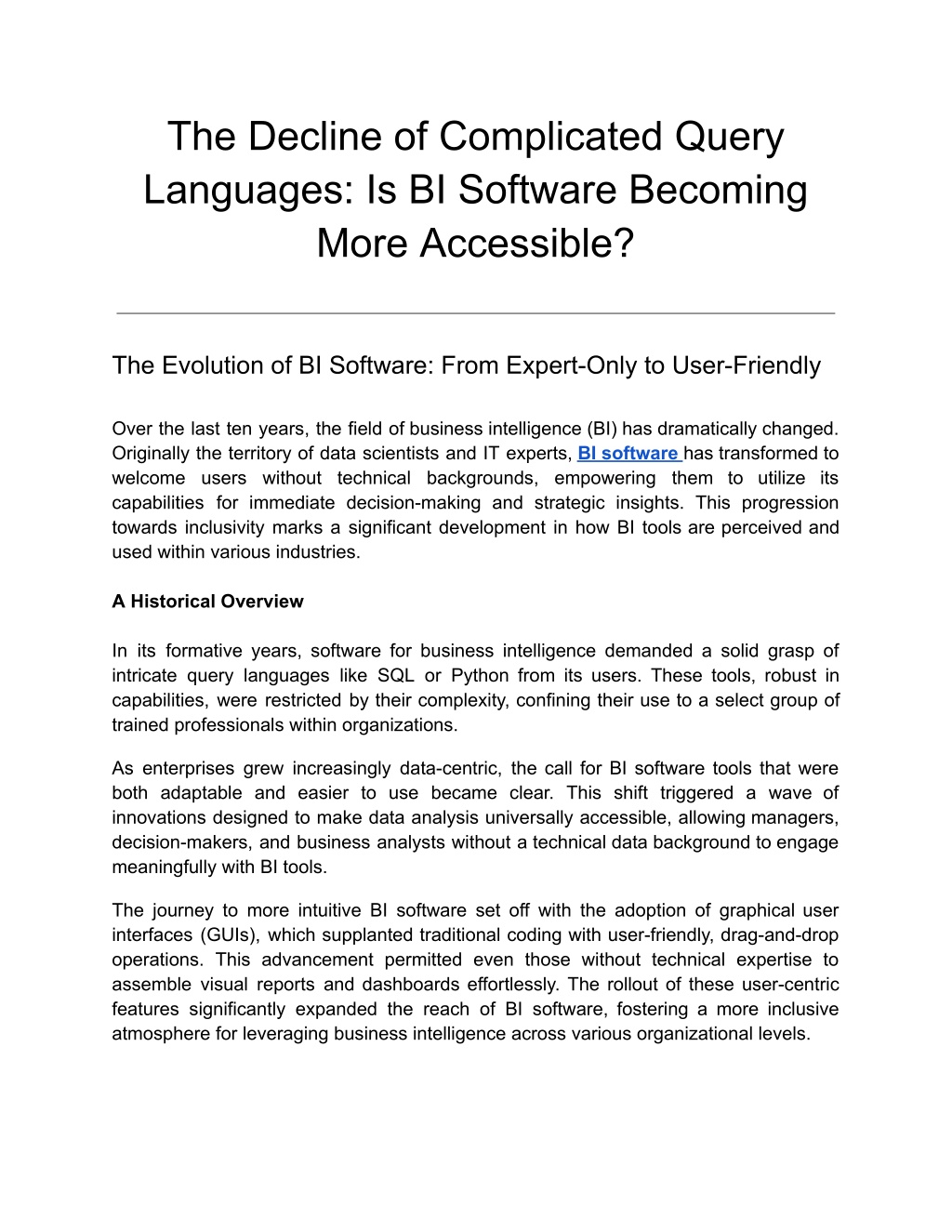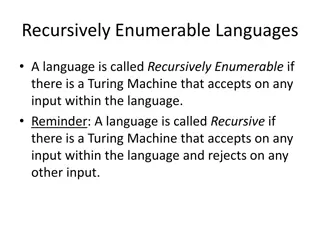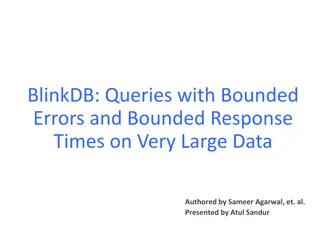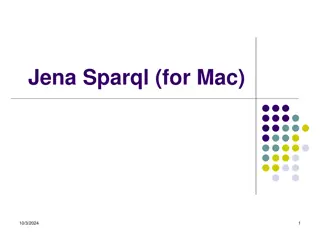
The Decline of Complicated Query Languages_ Is BI Software Becoming More Accessible_
Discover the shift towards simpler, more accessible BI software tools as we explore the decline of complicated query languages in the business intelligence landscape. This blog post discusses the impact of user-friendly interfaces on organizational d
Download Presentation

Please find below an Image/Link to download the presentation.
The content on the website is provided AS IS for your information and personal use only. It may not be sold, licensed, or shared on other websites without obtaining consent from the author. Download presentation by click this link. If you encounter any issues during the download, it is possible that the publisher has removed the file from their server.
E N D
Presentation Transcript
The Decline of Complicated Query Languages: Is BI Software Becoming More Accessible? The Evolution of BI Software: From Expert-Only to User-Friendly Over the last ten years, the field of business intelligence (BI) has dramatically changed. Originally the territory of data scientists and IT experts, BI software has transformed to welcome users without technical backgrounds, empowering them to utilize its capabilities for immediate decision-making and strategic insights. This progression towards inclusivity marks a significant development in how BI tools are perceived and used within various industries. A Historical Overview In its formative years, software for business intelligence demanded a solid grasp of intricate query languages like SQL or Python from its users. These tools, robust in capabilities, were restricted by their complexity, confining their use to a select group of trained professionals within organizations. As enterprises grew increasingly data-centric, the call for BI software tools that were both adaptable and easier to use became clear. This shift triggered a wave of innovations designed to make data analysis universally accessible, allowing managers, decision-makers, and business analysts without a technical data background to engage meaningfully with BI tools. The journey to more intuitive BI software set off with the adoption of graphical user interfaces (GUIs), which supplanted traditional coding with user-friendly, drag-and-drop operations. This advancement permitted even those without technical expertise to assemble visual reports and dashboards effortlessly. The rollout of these user-centric features significantly expanded the reach of BI software, fostering a more inclusive atmosphere for leveraging business intelligence across various organizational levels.
Another major breakthrough was the development of self-service BI platforms. These platforms empower users to conduct queries, generate reports, and derive insights independently, without constant IT department intervention. Self-service tools often come with pre-built templates and connectors for common data sources, which streamline the setup and use of BI software tools, making them more appealing across organizational levels. Integration of AI and ML The incorporation of artificial intelligence (AI) and machine learning (ML) has further simplified the interaction with BI software. AI capabilities, such as natural language processing (NLP), allow users to make queries in plain language, such as "What was
our sales growth in the last quarter?" The software interprets these queries and provides answers directly, a far cry from the days of manually coding complex SQL queries. This AI integration does not only make BI tools more accessible but also more powerful, as ML algorithms can identify trends and patterns that may not be immediately obvious to human analysts. This level of advanced analytics was once only within the reach of experts but is now available to a broader audience, enhancing the strategic decision-making process across different levels of a business. BI Software Pricing and Accessibility As BI tools have become more user-friendly, the pricing models have also adapted to accommodate the growing market. BI software pricing now often includes various tiers, which allows small businesses and startups to adopt these tools without the hefty initial investment that was previously required. This tiered pricing strategy ensures that businesses only pay for the level of functionality they need, which can scale as the business grows. Why Complicated Query Languages Are Falling Out of Favor In the realm of data-driven decision-making, the complexity of tools can often be a barrier to accessibility and efficiency. This is particularly true with traditional BI software, which has historically relied on complicated query languages that require specialized knowledge. As the business landscape evolves towards more dynamic and inclusive environments, there's a noticeable shift away from these complex systems towards more user-friendly BI software tools. Let s explore why complicated query languages are losing ground and how modern software for business intelligence is transforming the analytics domain. The Barriers of Complexity Complicated query languages like SQL, Python, or R have been the backbone of traditional BI software tools. These languages, while powerful, require a significant amount of technical skill and training. The need for specialized data analysts or IT professionals to interpret data or craft queries creates a bottleneck in workflows, delaying the decision-making process which is increasingly becoming more real-time. The reality is that not all business users are tech-savvy, and the steep learning curve associated with these languages can be a major deterrent. This complexity limits the
agility of a business, as only a handful of employees are equipped to handle these tools, which isn t conducive to the fast-paced needs of modern businesses. The Rise of User-Friendly BI Software As businesses recognize the limitations imposed by complicated query languages, there has been a surge in demand for more accessible BI software tools. These tools are designed with the end-user in mind, often featuring drag-and-drop interfaces, intuitive dashboards, and the ability to perform complex analyses with simple commands. This shift is driven by the need to democratize data analytics, enabling users across organizational levels to interact with data directly and derive actionable insights. Impact on BI Software Pricing The changing preferences have also influenced BI software pricing models. Vendors are now offering flexible pricing strategies to accommodate the wide array of businesses seeking to leverage BI tools. By providing tiered pricing models, BI software becomes accessible not only to large enterprises but also to small and medium-sized businesses. This flexibility in BI software pricing ensures that companies can choose solutions that match their specific needs without overspending on unnecessary features. Enhanced Collaborative Features Modern BI software tools are built to support collaboration across departments. In contrast to the siloed approach necessitated by complex query languages, these newer tools promote a more collaborative and transparent data culture within organizations. Features such as shared dashboards and real-time data updates help ensure that all team members are on the same page, fostering a more inclusive environment for strategic planning and decision-making. The Role of AI and Automation To bridge the gap between complex data analysis and user-friendly interfaces, many BI tools now incorporate AI and automation. These technologies can automate routine data processing tasks and translate natural language queries into meaningful data insights. This not only reduces the reliance on traditional query languages but also speeds up the analytical processes, allowing businesses to respond more swiftly to market changes and internal dynamics. How Accessibility in BI Tools Impacts Business Outcomes
The accessibility of BI software plays a crucial role in determining the efficiency and agility of organizational decision-making. As companies increasingly rely on data to drive business strategies, the democratization of software for business intelligence is not just a technical improvement but a fundamental shift in how businesses operate and compete. Enhancing Decision-Making Speed The primary benefit of increased accessibility in BI tools is the significant acceleration of decision-making processes. Traditional BI setups, often cumbersome and complex, required the involvement of data specialists to extract meaningful insights. Modern BI software tools, however, are designed with user-friendly interfaces that enable non-technical staff to perform advanced data analysis without waiting for IT intervention. This shift not only speeds up individual decision-making but also enhances the overall responsiveness of the company to market changes. Broadening Data Literacy Within Organizations
Accessible BI tools help foster a culture of data literacy across all levels of an organization. By providing all employees with access to BI software, companies empower their teams to understand and utilize data in their daily responsibilities. This widespread data literacy can lead to more informed and aligned decision-making across departments, reducing silos and enhancing cohesion within the business. Increased familiarity with BI software tools also encourages a more questioning and analytical work environment, where decisions are consistently backed by data. Reducing Costs Through Efficient BI Software Pricing As BI tools become more accessible, the BI software pricing models also evolve to accommodate a broader range of businesses. Many BI vendors now offer scalable solutions that businesses can customize according to their specific needs. This flexibility in BI software pricing ensures that companies do not overinvest in overly complex systems that exceed their actual requirements. Instead, they can select and scale features as needed, optimizing their return on investment and reducing unnecessary expenditure on unused capabilities. Improving Customer Insights and Engagement The accessibility of BI software tools enables businesses to gather and analyze customer data more effectively. With advanced analytics features becoming more user-friendly, companies can track customer behavior, preferences, and feedback in real-time. This immediate access to customer insights allows businesses to tailor their products, services, and marketing strategies more effectively, leading to improved customer satisfaction and loyalty. Enhanced engagement through data-driven strategies directly impacts revenue growth and competitive positioning. Facilitating Regulatory Compliance and Risk Management In industries where regulatory compliance is crucial, accessible BI software can streamline the process of generating reports that adhere to legal standards. Simplified data aggregation and reporting through BI tools reduce the risk of human error and ensure accuracy in critical financial and operational reports. Moreover, enhanced accessibility allows for better monitoring of compliance metrics, enabling proactive management of potential risks before they snowball into more significant issues. Potential Downsides of Over-Simplification in BI Software
While the trend towards more user-friendly BI software has opened up data analytics to a broader audience, it's important to consider the potential downsides of oversimplifying complex tools. In striving for simplicity, software for business intelligence may lose some of the depth and flexibility that allow for nuanced insights and data manipulation. Loss of Detailed Data Manipulation One of the primary concerns with the oversimplification of BI tools is the potential loss of detailed data manipulation capabilities. Advanced data analysis often requires complex queries that simple drag-and-drop interfaces may not support. For seasoned data professionals, this can mean a frustrating limitation in their ability to drill down into the data or customize reports to the extent they need. As BI software becomes more user-friendly, it's crucial to ensure that these simplifications do not strip away the advanced functionalities that allow for a deeper data exploration. Risk of Misinterpretation Over-simplification can also lead to a higher risk of data misinterpretation. When BI software tools automate the process of data analysis, there's a chance that users without a background in data science may misinterpret the outputs, leading to decisions based on incorrect assumptions. This is particularly risky in complex scenarios where data requires careful consideration of context and variables. Businesses must balance making BI tools accessible while also ensuring that users are sufficiently educated about the potential pitfalls of misinterpretation. Generic Insights Limiting Strategic Decisions Another downside to the oversimplification of BI software is the potential for generating only surface-level insights. While these may suffice for routine decision-making, they might not provide the depth required for strategic planning. High-level, generic insights can hinder a company s ability to conduct thorough competitive analysis or to identify subtle market shifts. For BI software to truly add value, it must offer a balance between user-friendly interfaces and the capacity to deliver complex, actionable insights. Dependence on Vendor-Specific Capabilities As companies rely more heavily on simplified BI tools, they may become overly dependent on specific vendors for critical analytics capabilities. This can lead to issues with data portability and flexibility if the business decides to switch platforms. Additionally, the pricing of BI software tools can be influenced by the level of simplification and integration they offer, potentially leading to higher costs for businesses as they pay for premium features that are tied to user-friendly designs.
Overlooked Customization Needs In the quest to make BI tools accessible to non-technical users, there's also a risk of overlooking the customization needs of different industries or business sizes. Not all business intelligence requirements are the same, and a one-size-fits-all approach may not effectively address specific business challenges. BI software must be versatile enough to adapt to diverse business environments, offering both simplicity for new users and advanced options for more complex needs. Strategies to Mitigate Over-Simplification To address these downsides, businesses should: Opt for BI software that offers different levels of complexity based on the user's proficiency. Provide adequate training and resources to ensure that users understand the tools and the data they are working with. Choose BI software tools that maintain a balance between user-friendly interfaces and advanced analytical capabilities. Evaluate BI software pricing not just on the cost but also on the value it brings in terms of customization and scalability. Conclusion The decline of complicated query languages in favor of more accessible, user-friendly BI software is transforming the landscape of business intelligence. As these tools become easier to use, more individuals within an organization can engage directly with data, enhancing their ability to make informed decisions quickly and independently. This shift is not merely a trend but a significant movement towards democratizing data analytics, ensuring businesses of all sizes can leverage the power of BI to drive success. At Grow, we understand the importance of making sophisticated data analysis accessible to everyone in your organization. That's why our BI software tools are designed to be intuitive and easy to use, without sacrificing the powerful capabilities that data professionals need. Whether you are a business user seeking to generate actionable insights or a data analyst looking to dive deep into complex data sets, Grow's platform can accommodate your needs seamlessly. We invite you to experience the ease and power of Grow's BI solutions firsthand. Sign up today for a 14-day free trial and explore how our tools can transform your data into actionable insights effortlessly. Additionally, we encourage you to review the "Grow
Pricing 2024 Capterra" to see how our flexible pricing plans can fit into your budget while delivering the value you expect from a top-tier BI tool. Don't let outdated complexities hold your business back. Join the growing number of companies that are making the switch to more accessible BI solutions with Grow. Original Source: https://bit.ly/4cIVBd8






















